In this post, you’re going to learn everything you need to know about the upper/lower split for working out.
Specifically, we will:
- compare the upper/lower split to other types of training routines,
- teach you how to create an ideal upper/lower routine for the gym or at home
- give you 2, 3, and 4 day templates you can use today
Let’s get started.
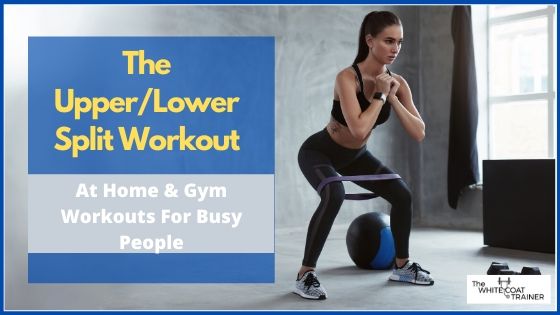
What Is The Upper/Lower Split?
The upper-lower split is a training method in which you exercise your upper body on one day and your lower body on another.
This is in contrast to:
- the full-body split, where you train major muscle groups from both your upper and lower body on the same day,
- the push pull legs split where you divide your training by muscle action,
- and the bro split, which divides training by distinct muscle groups on separate days
Let’s go over the major benefits of this style of training.
The 4 Main Benefits of Upper/Lower Workouts
So why would you want to use the upper/lower workout routine? Here are the 4 advantages.
#1 It Simplifies Your Training Sessions:
Some workout programs can get very complicated. Especially if you are doing several exercises, and mixing and matching upper and lower body exercises per day.
With the upper/lower split, each workout is specifically tailored to just a few key muscle groups.
In general, you will train 3-4 upper body exercises on one day, and 3-4 lower body exercises on another.
#2 It Maximizes Recovery Time:
By training your upper body on one day, then your lower body on another, you allow for a decent amount of rest days between sessions.
For example:
On a 4 day/week workout program – you will take one day off after training the upper body and the lower body. This will then give you a full 72 hours before you train the upper body again.
In general, you want at least 48 hours of rest before training the exact same muscle group.
Related Post: How To Maximize Recovery Between Workouts (7 Key Methods).
#3 It Minimizes Exercise Overlap:
Some workout programs inadvertently train the same muscle groups too frequently.
If you bench press on Monday, and shoulder press on Tuesday, your shoulders may not be fully recovered to perform at their best.
This isn’t necessarily a bad thing, but the upper/lower split eliminates this issue.
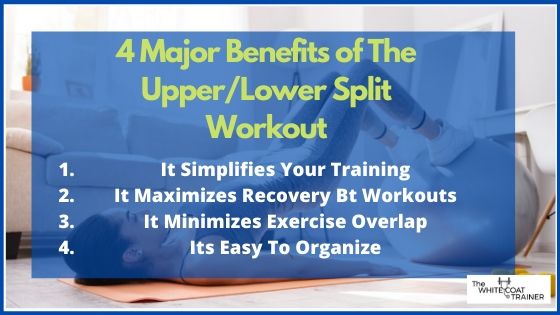
#4 Easy to organize:
Lastly, it’s easy to write an upper/lower workout program.
As long as you select the right exercises, it’s difficult to mess up your workouts.
In fact, you can get away with doing just two unique workouts, twice a week.
I’ll show you how in just a few moments.
So now let’s get to the actual workouts.
How Do I Make My Upper/Lower Split?
Okay, so what is the best way to design your upper/lower workout plan?
It starts with
- choosing 3-4 upper body exercises
- choosing 3-4 lower body exercises
Here are the exercises:
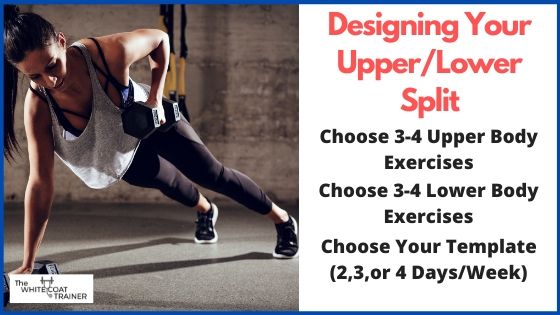
Upper Body Exercises
We can divide the upper body exercises into 4 main categories.
- the Horizontal Push,
- the Pull,
- the Vertical Push,
- and Isolation Exercises
Those are all the exercises you need.
For your upper body days, you only need to train these 4 movement patterns.
The first three categories involve compound lifts. That’s just a fancy way of saying that they train multiple muscle groups at once.
That’s in contrast to isolation exercises, which generally focus on one muscle group. When you use compound movements, you can get away with doing fewer exercises.
Choose 1-2 exercises from each category for your training program.
You don’t need to do 3 or 4 different kinds of bench presses. You don’t need to do tricep pushdowns, followed by tricep kickbacks, followed by EZ bar tricep extensions.
Next, let’s go over some examples.
The horizontal push focuses on the pressing muscles on the anterior side of your body, as well as your triceps.
Here is a list of some of the most high-yield horizontal pushing exercises.
Gym Variations:
- Barbell Bench Press:(and all variations)
- Incline Bench Press: (and all variations)
- Dumbbell Bench Press: (and all variations)
Home Variations:
- Push-Ups:(and all variations)
- Decline Push-ups (and all variations)
- Band Floor Press (requires the use of closed-loop resistance band [get them here on Amazon])
Decline Push-Ups:
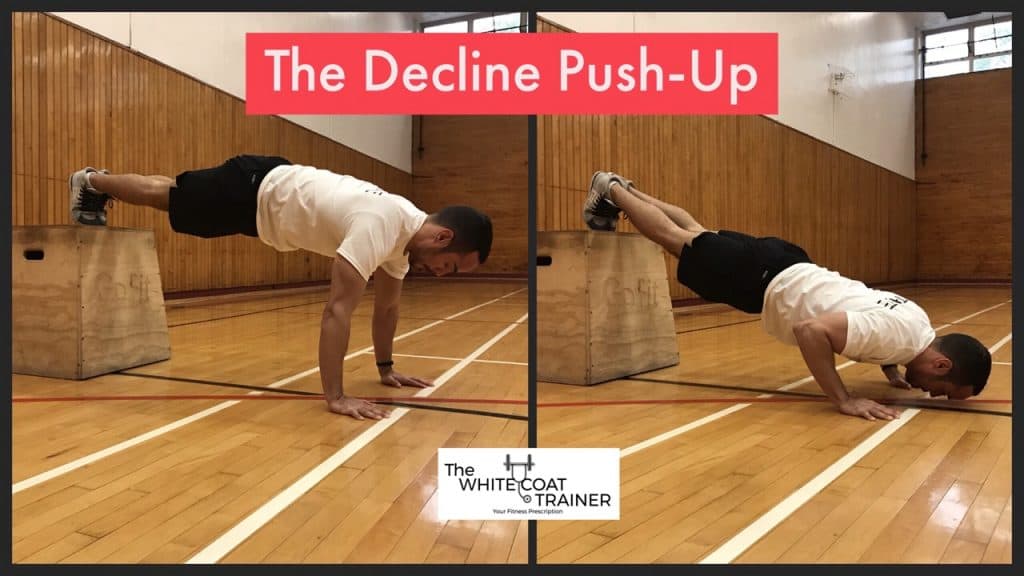
Banded Floor Press
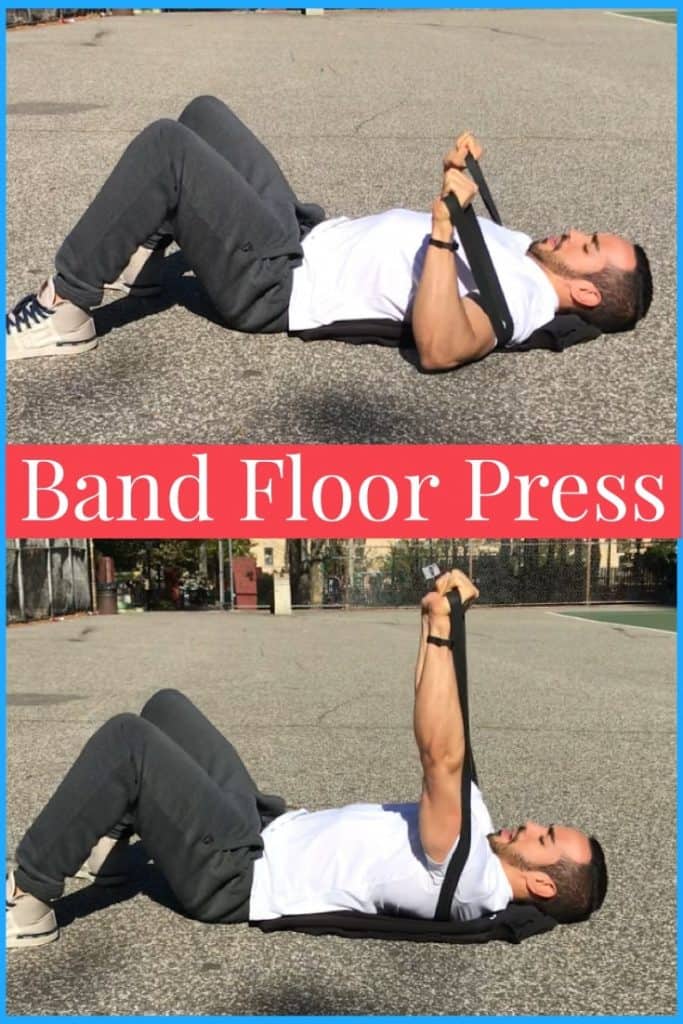
Upper Body Pull Exercises:
Next up is the pull.
The pull exercises focus on the muscles on the posterior side of your body such as your rhomboids, traps, posterior shoulders, and lats.
Gym Variations:
Home Variations:
- Bent Over Banded Row (requires the use of closed-loop resistance band [get them here on Amazon])
- Inverted Rows
- Pull-ups (requires a
pull-up bar )
Bent Knee Inverted Row
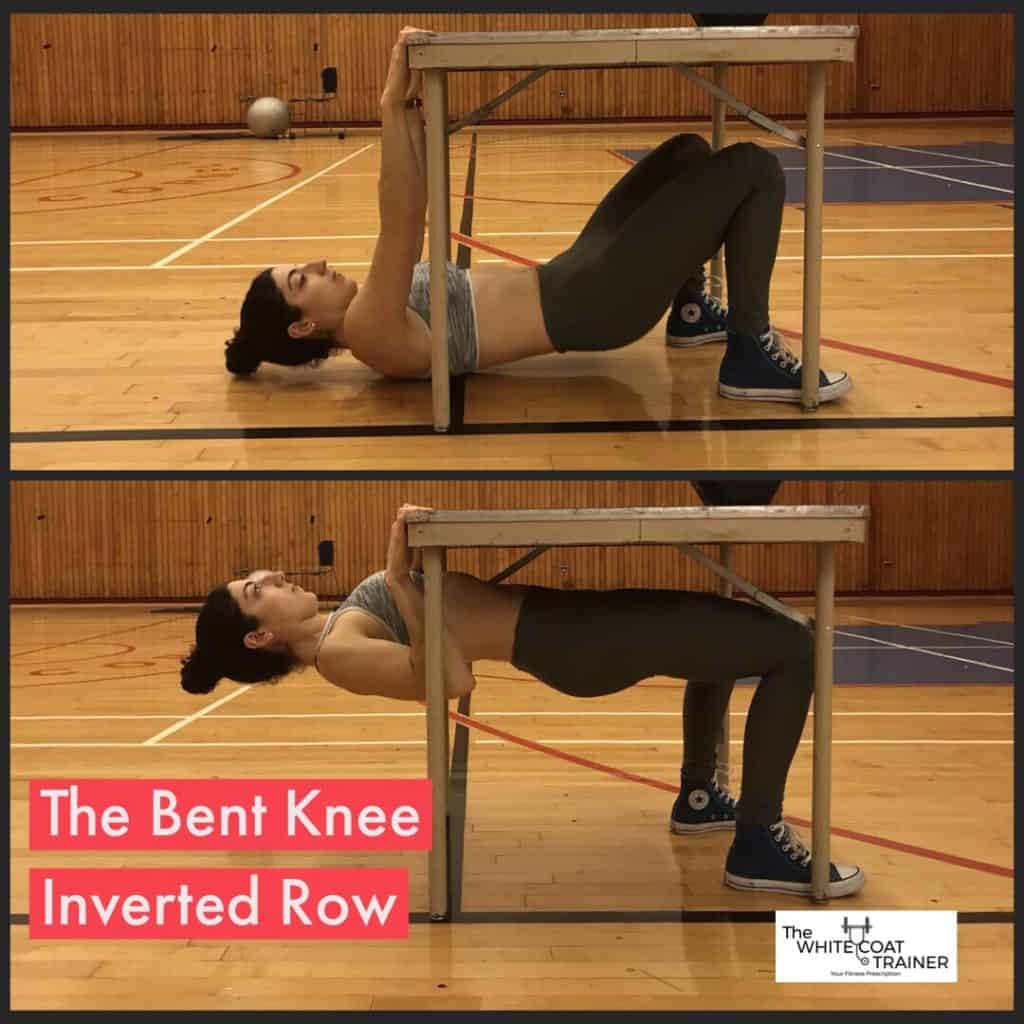
Bent Over EZ Bar Row
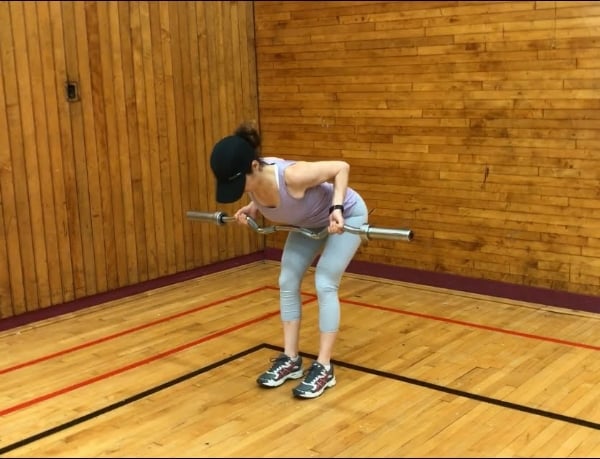
Vertical Push Exercises:
The third is the vertical push.
The vertical push trains your ability to press things overhead. These exercises focus on your shoulders, triceps, rotator cuff, and core stabilization.
Gym Variations:
Home Variations:
- Banded Overhead Press (requires the use of closed-loop resistance band [get them here on Amazon])
- Pike Push-ups
- Handstands
Pike Push-up
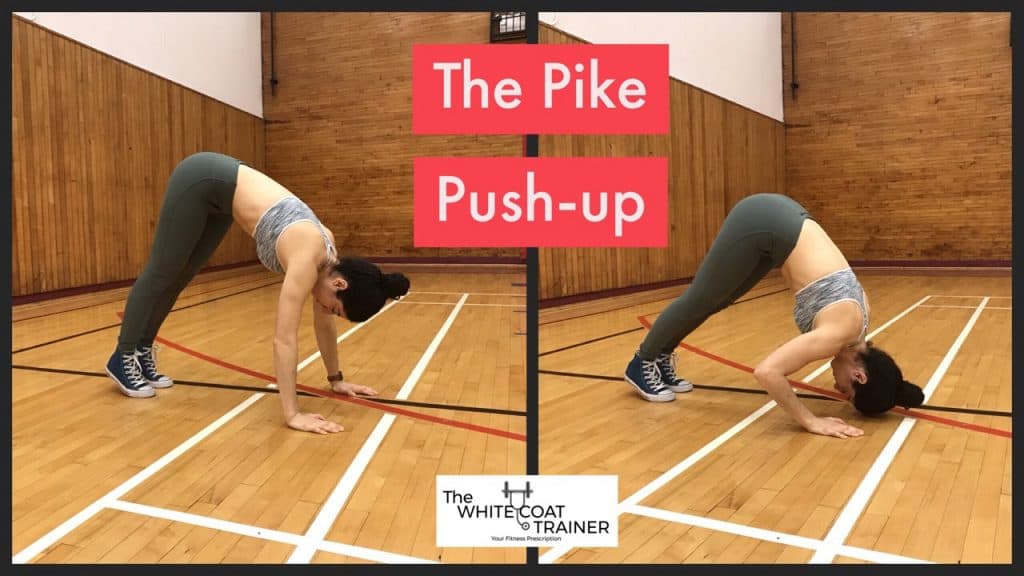
Handstands
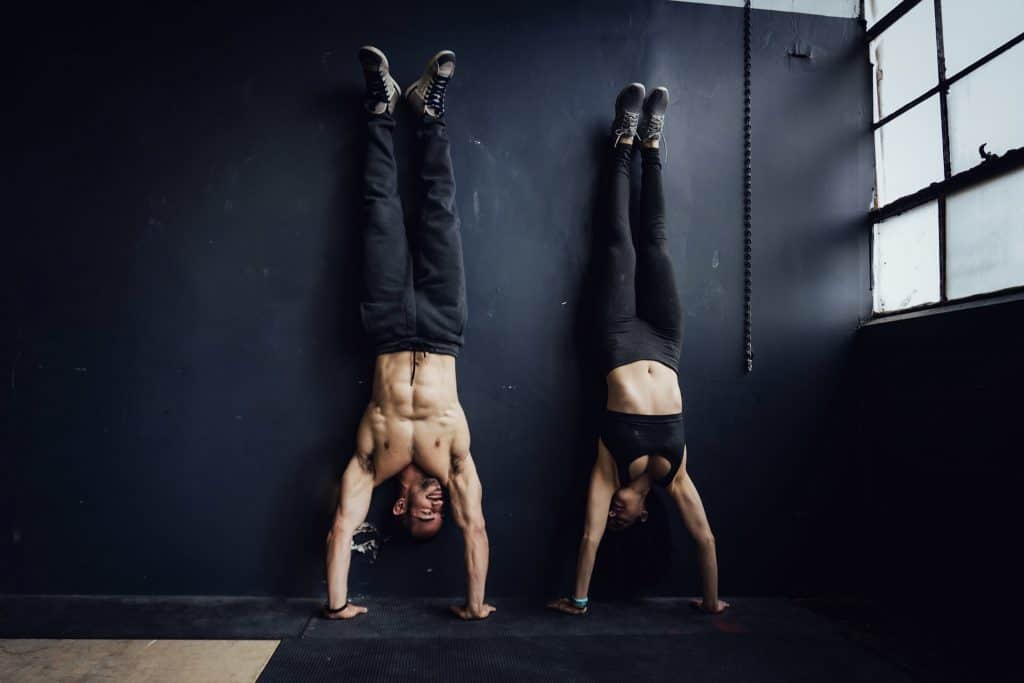
Isolation Exercises:
Lastly, you can incorporate some isolation movements into your upper body days. These are optional, and will not make or break your training.
If you are going to do them, I would say to stick with “pull focus” isolation exercises like the face pull.
Gym Variations:
- All dumbbell and barbell bicep curl variations
- All dumbbell or barbell tricep extension variations
- Face pulls
Home Variations:
- Banded Face pulls (requires the use of closed-loop resistance band [get them here on Amazon])
- Banded Bicep and Tricep work (requires the use of closed-loop resistance band [get them here on Amazon])
- Bodyweight tricep extensions
Bodyweight Tricep Extensions
That is all.
Choose 1-2 exercises from each of those categories and move on.
Next up are the lower body exercises.
Lower Body Exercises:
Similarly, the lower body exercises can also be divided into 4 categories. They are
- The Knee Flexion exercises,
- The Hip Extension exercises,
- The Core Stabilization exercises,
- and Isolation exercises
The first three categories are compound exercises, while the last category focuses on your calves.
Choose 1-2 exercises from each category for your training program.
Let’s go over them now.
Knee Flexion Exercises:
Knee flexion exercises focus on training your ability to squat up and down. As such, they strengthen your quadriceps, abductors, and glute muscles.
Gym Variations:
- Squats (and all variations)
- Front Squat
- Leg Press
Home Variations:
- Bodyweight squats (and all variations)
- Band Squats (requires a closed-loop resistance band)
- Step-ups (and all variations)
- Lunges (and all variations)
- Split Squats
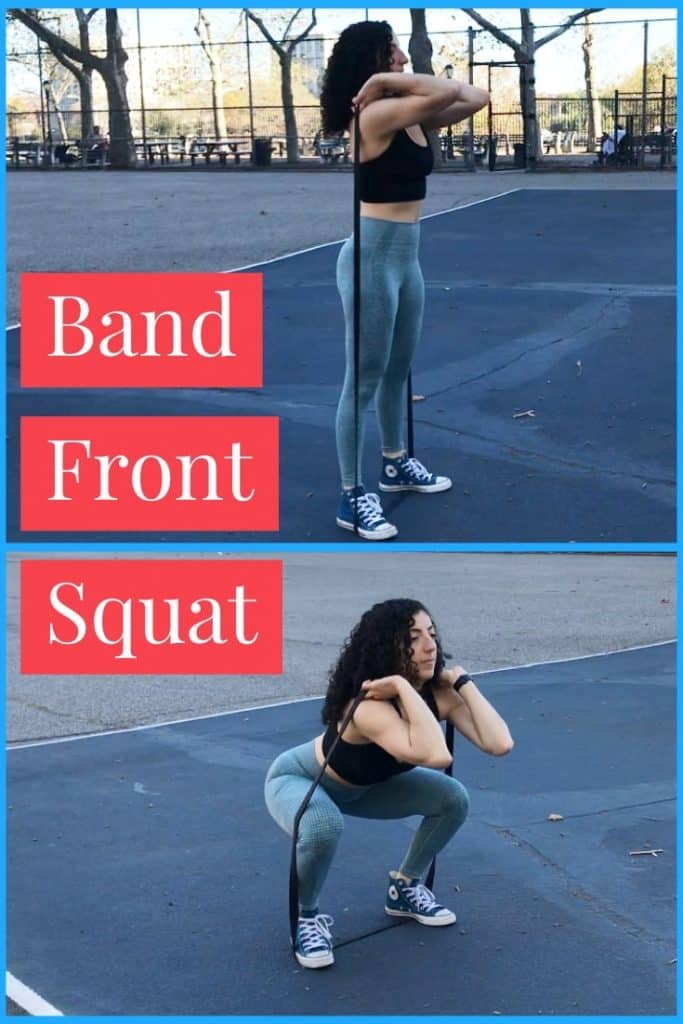
Bulgarian Split Squats
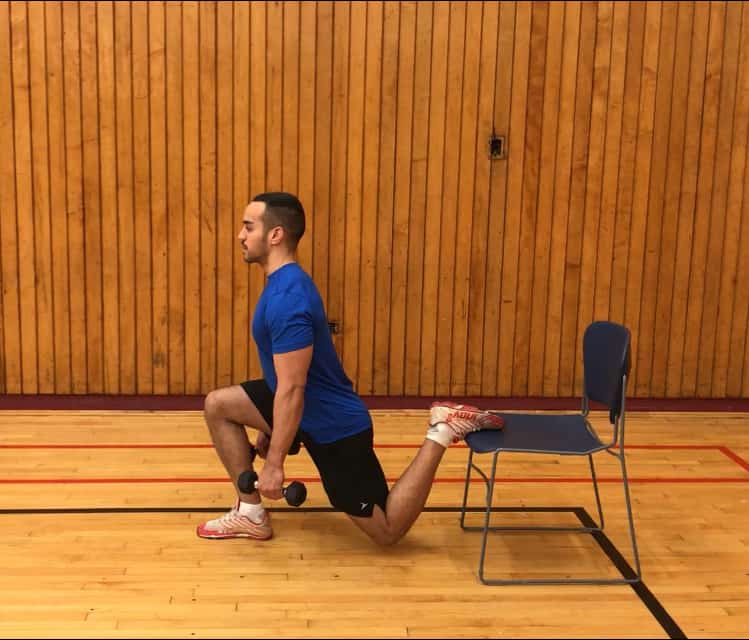
Hip Extension Exercises:
Next up is hip extension. These exercise primarily focus on your hamstrings, glutes, and lower back muscles.
Gym Variations:
Home Variations:
- Glute Bridge (and all variations)
- Single-Leg Romanian Deadlifts
- Banded Good mornings (requires a closed-loop resistance band)
- Band Deadlifts
Band Goodmorning

Core Exercises:
We can’t forget the abs.
The core exercises will strengthen and develop your rectus abdominis, transverse abdominis, and your oblique muscles.
The gym and home variations are the same.
- Planks
- Side Planks
- Ab Rollouts (requires an ab wheel- get one cheap on Amazon)
- Reverse Crunches
- Carries
- Hanging Leg Raises
- Hollow Body Holds
Modified Hollow Body Hold
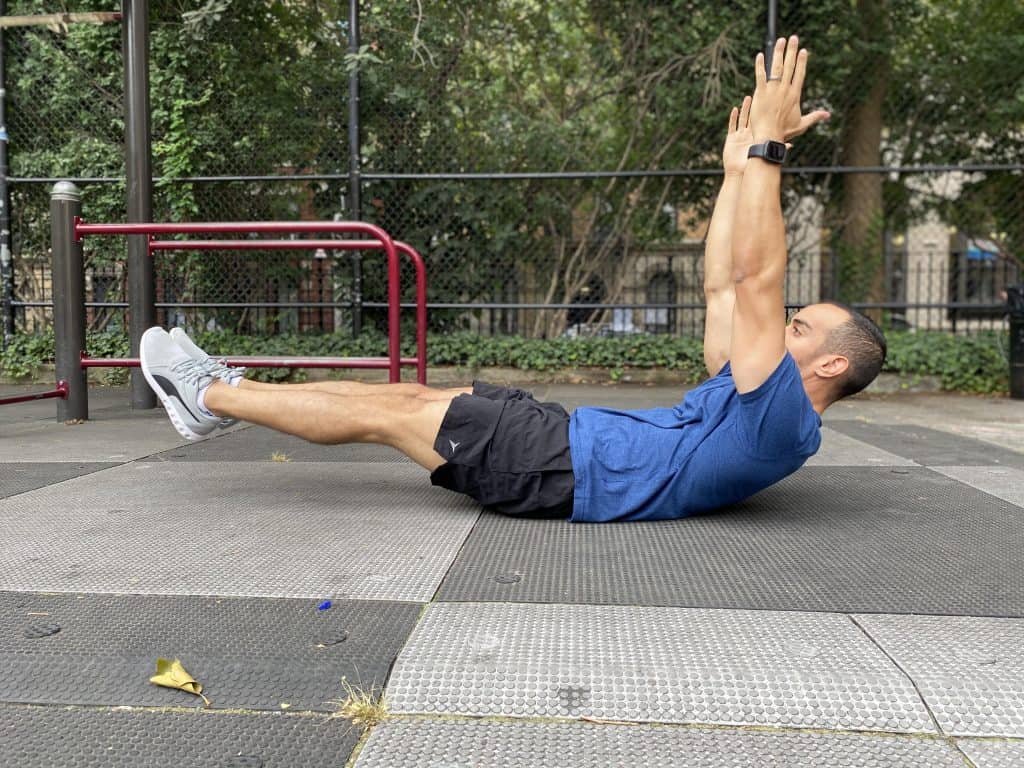
Isolation Exercises: (Calves)
Lastly, you can choose to add some calf work to your lower body days. This is totally optional.
(I’ll admit, I never train my calves- and it shows)
- Standing calf raises
- Single leg calf raises
This Isn’t A Comprehensive List Of The Exercises You Can Choose From – For More Exercises…
This is not a comprehensive list of exercises you can do. For more exercises in each category, be sure to check out:
- The Ultimate List of Compound Movements (46 Exercises You Should Know)
- The Complete List of Calisthenic Exercises (Beginner to Advanced Variations)
- Full-Body Resistance Band Exercises (20+ Exercises To Choose From)
The first one is for more gym exercises.
The second one is for more home/bodyweight exercises.
The third one is for more resistance band exercises.
Enjoy.
The Upper Lower Split Templates
Okay, now let’s get to the actual workouts.
Below, I have provided 2, 3, or 4-day week upper/lower templates for both the gym and at-home workouts.
These workouts should only take 30-45 minutes max.
2 Days A Week Upper/Lower Workout (At The Gym)
The 2 day/week template should be done only by the busiest of people.
Working out twice per week won’t yield the best results due to the low training volume, but something is always better than nothing.
If you use the 2 day/week program, spread the workouts out as evenly as possible. For example, you can do the first workout on Monday, and the second one on Thursday.
Upper Body Workout
Here is the template
- Horizontal Push Exercise, 3-4 sets, 7-12 reps
- Pull Exercise, 3-4 sets, 7-12 reps
- Vertical Push Exercise, 3-4 sets, 7-12 reps
- Isolation Exercise (pull focus), 3-4 sets, 7-12 reps
Here is what I recommend:
| Exercise | Sets | Reps/Set |
| Barbell Bench Press | 3-4 | 7-12 |
| Barbell Row | 3-4 | 7-12 |
| Overhead Press | 3-4 | 7-12 |
| Face Pulls | 3 | 7-12 |
Lower Body Workout
Here is the template
- Knee Flexion Exercise, 3-4 sets, 7-12 reps
- Hip Extension Exercise, 3-4 sets, 7-12 reps
- Core Exercise, 3-4 sets, 7-12 reps (or 20-30 second holds)
- Isolation Exercise (Optional), 3-4 sets, 7-12 reps
| Exercise | Sets | Reps |
| Barbell Back Squat | 3-4 | 7-12 |
| Romanian Deadlifts | 3-4 | 7-12 |
| Side Planks | 3-4 | 20 sec/each |
| Weighted Calf Raises (Optional) | 3 | 7-12 |
2 Days A Week Upper/Lower Workout (At Home)
Upper Body Workout
Here is the template
- Horizontal Push Exercise, 3-4 sets, 7-12 reps
- Pull Exercise, 3-4 sets, 7-12 reps
- Vertical Push Exercise, 3-4 sets, 7-12 reps
- Isolation Exercise (pull focus), 3-4 sets, 7-12 reps
Here is what I recommend:
| Exercise | Sets | Reps |
| Push-up variation | 3-4 | 7-12 |
| Inverted Row or Pull-up | 3-4 | 7-12 |
| Pike Push-ups | 3-4 | 7-12 |
| Band Face Pulls | 3 | 7-12 |
Lower Body Workout
Here is the template
- Knee Flexion Exercise, 3-4 sets, 7-12 reps
- Hip Extension Exercise, 3-4 sets, 7-12 reps
- Core Exercise, 3-4 sets, 7-12 reps (or 20-30 second holds)
- Isolation Exercise (Optional), 3-4 sets, 7-12 reps
| Exercise | Sets | Reps |
| Squat variation | 3-4 | 7-12 |
| Single-Leg Romanian Deadlifts | 3-4 | 7-12/each |
| Side Planks | 3-4 | 20 sec/each |
| Calf Raises (Optional) | 3 | 7-12 |
3 Days A Week Upper/Lower Workout (At The Gym)
3 days a week is better than 2 days a week, as you can practice the movements more frequently.
Using the 3 day a week template, one full training cycle will take two weeks.
For example, here’s what your workout schedule should look like:
WEEK 1
| Monday | Tuesday | Wednesday | Thursday | Friday | Saturday | Sunday |
|---|---|---|---|---|---|---|
| Upper Day | Off | Lower Day | Off | Upper Day | Off | Off |
WEEK 2
| Monday | Tuesday | Wednesday | Thursday | Friday | Saturday | Sunday |
|---|---|---|---|---|---|---|
| Lower Day | Off | Upper Day | Off | Lower Day | Off | Off |
In this scenario, I recommend that you only use two unique workouts.
For example, the workout you do on Monday and Friday of week 1 is the same, as is the workout on Wednesday of the next week.
Here are the workouts.
Upper Body Workout
Here is the template
- Horizontal Push Exercise, 3-4 sets, 7-12 reps
- Pull Exercise, 3-4 sets, 7-12 reps
- Vertical Push Exercise, 3-4 sets, 7-12 reps
- Isolation Exercise (pull focus), 3-4 sets, 7-12 reps
Here is what I recommend:
| Exercise | Sets | Reps |
| Barbell Bench Press | 3-4 | 7-12 |
| Barbell Row | 3-4 | 7-12 |
| Overhead Press | 3-4 | 7-12 |
| Face Pulls | 3 | 7-12 |
Lower Body Workout
Here is the template
- Knee Flexion Exercise, 3-4 sets, 7-12 reps
- Hip Extension Exercise, 3-4 sets, 7-12 reps
- Core Exercise, 3-4 sets, 7-12 reps (or 20-30 second holds)
- Isolation Exercise (Optional), 3-4 sets, 7-12 reps
| Exercise | Sets | Reps |
| Barbell Back Squat | 3-4 | 7-12 |
| Romanian Deadlifts | 3-4 | 7-12 |
| Side Planks | 3-4 | 20 sec/each |
| Weighted Calf Raises (Optional) | 3 | 7-12 |
3 Days A Week Upper/Lower Workout (At Home)
Upper Body Workout
Here is the template
- Horizontal Push Exercise, 3-4 sets, 7-12 reps
- Pull Exercise, 3-4 sets, 7-12 reps
- Vertical Push Exercise, 3-4 sets, 7-12 reps
- Isolation Exercise (pull focus), 3-4 sets, 7-12 reps
Here is what I recommend:
| Exercise | Sets | Reps |
| Push-up variation | 3-4 | 7-12 |
| Inverted Row or Pull-up | 3-4 | 7-12 |
| Pike Push-ups | 3-4 | 7-12 |
| Band Face Pulls | 3 | 7-12 |
Lower Body Workout
Here is the template
- Knee Flexion Exercise, 3-4 sets, 7-12 reps
- Hip Extension Exercise, 3-4 sets, 7-12 reps
- Core Exercise, 3-4 sets, 7-12 reps (or 20-30 second holds)
- Isolation Exercise (Optional), 3-4 sets, 7-12 reps
| Exercise | Sets | Reps |
| Squat Variation | 3-4 | 7-12 |
| Single-Leg Romanian Deadlifts | 3-4 | 7-12/ each |
| Side Planks | 3-4 | 20 sec/ each |
| Calf Raises (Optional) | 3 | 7-12 |
4 Days A Week Upper/Lower Workout (At The Gym)
The last routine is the 4 day a week template. This is my favorite template and the one I have used for the majority of my training career.
With the 4-day split, you have two options.
- You can use the same two workouts, doing each workout twice in 1 week
- You can use four unique workouts, 2 different upper body workouts and 2 different lower body workouts.
For example:
- Monday: Upper Body Day
- Tuesday: Lower Body Day
- Wednesday: Off
- Thursday: Upper Body Day
- Friday: Lower Body Day
In the example below, I will show you the best ways to design four unique workouts.
By the way, you can download a sample 4 day template using the upper lower body split PDF right here, FREE.
Here are the workouts.
Upper Body Workout #1
Here is the template
- Horizontal Push Exercise, 3-4 sets, 7-12 reps
- Pull Exercise, 3-4 sets, 7-12 reps
- Vertical Push Exercise, 3-4 sets, 7-12 reps
- Isolation Exercise (pull focus), 3-4 sets, 7-12 reps
Here is what I recommend:
| Exercise | Sets | Reps |
| Barbell Bench Press | 3-4 | 7-12 |
| Barbell Row | 3-4 | 7-12 |
| Overhead Press | 3-4 | 7-12 |
| Face Pulls | 3 | 7-12 |
Lower Body Workout #1
Here is the template
- Knee Flexion Exercise, 3-4 sets, 7-12 reps
- Hip Extension Exercise, 3-4 sets, 7-12 reps
- Core Exercise, 3-4 sets, 7-12 reps (or 20-30 second holds)
- Isolation Exercise (Optional), 3-4 sets, 7-12 reps
| Exercise | Sets | Reps |
| Barbell Back Squat | 3-4 | 7-12 |
| Romanian Deadlifts | 3-4 | 7-12 |
| Side Planks | 3-4 | 20 sec/each |
| Weighted Calf Raises (Optional) | 3 | 7-12 |
Upper Body Workout #2
Here is the template
- Vertical Push Exercise, 3-4 sets, 7-12 reps
- Pull Exercise, 3-4 sets, 7-12 reps
- Horizontal Push Exercise, 3-4 sets, 7-12 reps
- Isolation Exercise (pull focus), 3-4 sets, 7-12 reps
| Exercise | Sets | Reps |
| Dumbbell Shoulder Press | 3-4 | 7-12 |
| Seated Cable Row | 3-4 | 7-12 |
| Incline Bench Press | 3-4 | 7-12 |
| Biceps (optional) | 3 | 7-12 |
Lower Body Workout #2
Here is the template
- Hip Extension Exercise, 3-4 sets, 7-12 reps
- Knee Flexion Exercise, 3-4 sets, 7-12 reps
- Core Exercise, 3-4 sets, 7-12 reps (or 20-30 second holds)
- Isolation Exercise (Optional), 3-4 sets, 7-12 reps
| Exercise | Sets | Reps |
| Sumo Deadlifts | 3-4 | 7-12 |
| Reverse Lunges | 3-4 | 7-12 |
| Hanging Leg Raises | 3-4 | 7-12 |
| Weighted Calf Raises (Optional) | 3 | 7-12 |
4 Days A Week Upper/Lower Workout (At Home)
Upper Body Workout #1
Here is the template
- Horizontal Push Exercise, 3-4 sets, 7-12 reps
- Pull Exercise, 3-4 sets, 7-12 reps
- Vertical Push Exercise, 3-4 sets, 7-12 reps
- Isolation Exercise (pull focus), 3-4 sets, 7-12 reps
Here is what I recommend:
| Exercise | Sets | Reps |
| Push-up variation | 3-4 | 7-12 |
| Inverted Row | 3-4 | 7-12 |
| Pike Push-ups | 3-4 | 7-12 |
| Band Face Pulls | 3 | 7-12 |
Lower Body Workout #1
Here is the template
- Knee Flexion Exercise, 3-4 sets, 7-12 reps
- Hip Extension Exercise, 3-4 sets, 7-12 reps
- Core Exercise, 3-4 sets, 7-12 reps (or 20-30 second holds)
- Isolation Exercise (Optional), 3-4 sets, 7-12 reps
| Exercise | Sets | Reps |
| Squat variation | 3-4 | 7-12 |
| Single-Leg Romanian Deadlifts | 3-4 | 7-12/each |
| Side Planks | 3-4 | 20 sec/each |
| Calf Raises (Optional) | 3 | 7-12 |
Upper Body Workout #2
Here is the template
- Vertical Push Exercise, 3-4 sets, 7-12 reps
- Pull Exercise, 3-4 sets, 7-12 reps
- Horizontal Push Exercise, 3-4 sets, 7-12 reps
- Isolation Exercise (pull focus), 3-4 sets, 7-12 reps
| Exercise | Sets | Reps |
| Handstand Work or Dips | 3-4 | 7-12 |
| Pull-ups | 3-4 | 7-12 |
| Push-up Variation #2 | 3-4 | 7-12 |
| Band Face Pulls | 3 | 7-12 |
Lower Body Workout #2
Here is the template
- Hip Extension Exercise, 3-4 sets, 7-12 reps
- Knee Flexion Exercise, 3-4 sets, 7-12 reps
- Core Exercise, 3-4 sets, 7-12 reps (or 20-30 second holds)
- Isolation Exercise (Optional), 3-4 sets, 7-12 reps
| Exercise | Sets | Reps |
| Glute Bridge variation | 3-4 | 7-12 |
| Step-Ups | 3-4 | 7-12 |
| Planks | 3-4 | 30 sec |
| Calf Raises (optional) | 3 | 7-12 |
How Many Sets and Reps Should I Use With This Split?
So, how many sets and reps should you do to maximize your training?
The short answer is:
- Do 3-4 sets of each exercise for 7-12 repetitions if you are doing a gym workout.
- Do 3-4 sets of each exercise for 10-15 repetitions if you are doing a home workout.
But you should never use the same rep scheme all the time.
After a few weeks, you want to change it up. You can read more on why you should use these rep ranges in our article: How many sets and reps should you do?
How long should I rest between sets?
Okay, now let’s talk about rest periods. How long should you rest between sets?
The short answer is:
- Rest 3 minutes per set if you are doing a gym workout.
- Rest 2-3 minutes per set if you are doing a home workout.
To get more details, read our full post on rest periods.
How Much Weight Should I Lift?
Last but not least, how much weight should you lift if you are training at the gym?
The short answer is:
- Use a weight that is heavy enough where completing the prescribed rep range is a challenge, but not so heavy that you cannot maintain good form
- Also, err on the side of starting light, so that you have room to increase the weight as you get stronger.
To get the long answer- check out our post on how much weight should you lift.
What Variation Should I Choose For The Home Exercises?
Similarly, you should choose a bodyweight variation that is
- Challenging enough where completing the prescribed rep range is tough, but not so tough that you cannot maintain good form
- If using a resistance band, choose a band strong enough to challenge you to complete the prescribed rep range. In general, bands come in about 3-4 different strengths.
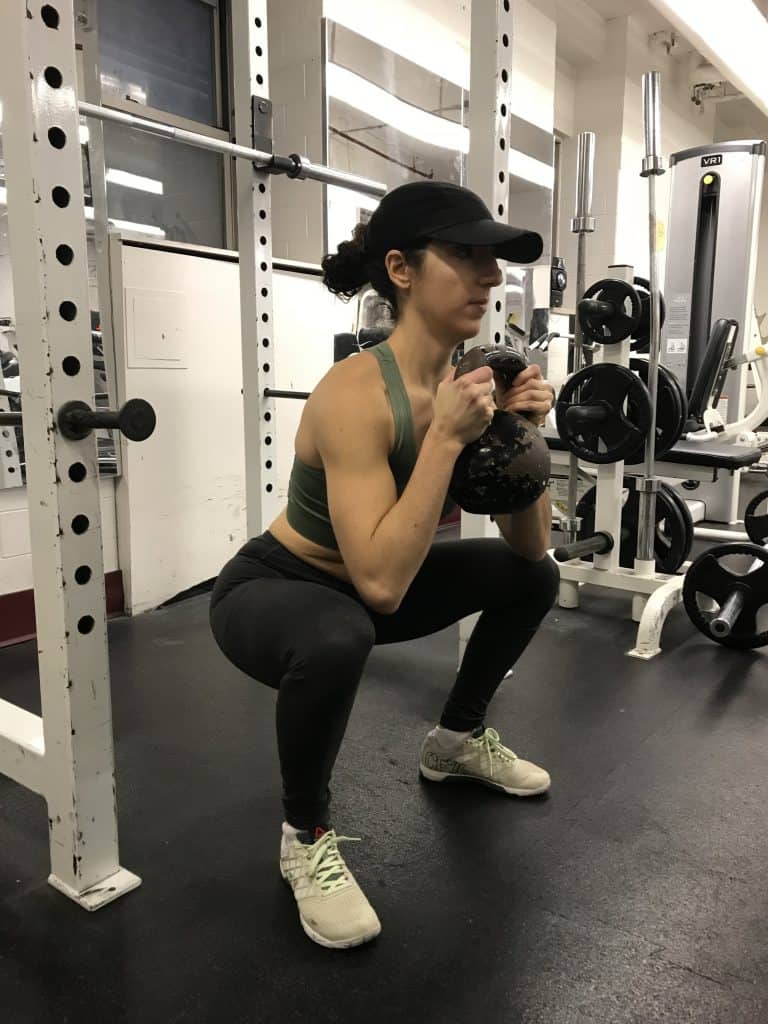
What About Cardio?
So what about cardio? Do you need to include aerobic work into your routine?
There’s no harm in doing cardio on your non – training days, and it can be very beneficial.
Experts recommend that you should get 150 minutes of moderate aerobic exercise per week.
I personally do not enjoy steady-state cardio, nor do I think it is necessary.
Unless you specifically enjoy cardio or are training to run a marathon, I don’t think you need to dedicate a lot of time “running” on a treadmill.
I personally get my moderate aerobic activity through brisk walking on a daily basis and keeping my HR high while working out.
This won’t qualify you for CrossFit games, but it should be good for the general population.
You can read more in my article: Is Cardio Actually Necessary?
Other Related Questions
So, Is The Upper/Lower split the best?
I personally think the upper/lower split is the best strength training routine for most people.
I have used this type of program for at least 50% of my training career.
But if you are an absolute beginner, I think you might benefit from a different workout split.
Are upper/lower splits good for beginners?
If you are a beginner, you are probably better off using a full-body training split.
Why?
Because full-body splits allow you to train each muscle group more frequently.
As a beginner, it is important that you learn how to perform compound exercises with good form. As such, practicing them more frequently will be beneficial to ingrain the proper technique.
With that said, beginners can still see a lot of benefits using the upper/lower split.
At the end of the day, you can’t go wrong with either approach.
If you want four great full body workouts, check out my free PDF!
However, most beginners make the mistake of using the bro split when first starting out.
BEGINNERS SHOULD NOT USE THE BRO SPLIT.
What is the bro split?
The bro split is one of the most common training routines used in commercial gyms.
With bro splits, you generally train only one or two body parts or muscles per day.
For example
- Monday: Chest and shoulders
- Tuesday: Biceps and Triceps
- Wednesday: Back
- Thursday: Legs
- Friday: Abs and Calves
As you could imagine, this is a very inefficient way to train. This isn’t a great option because:
- It leads you to think that you need to use several exercises to train each muscle
- You only train each muscle group per week
If you get nothing else out of this article, let it be this:
You do not need to do 5 different types of bicep curls and 4 different variations of bench press to see results.
1-2 exercises per muscle group are sufficient for what we are after – which is strength and muscle development.
This leads us to the next point.
What Is The Ideal Number Of Times To Train Each Muscle Group?
Research shows that training each muscle group twice per week is the most beneficial for strength and muscle development.
A three times per week training frequency may be better for muscle growth, but we don’t know for certain.
But as busy professionals, we usually don’t have that much time to devote to exercising.
So I recommend that you stick to twice per week.
Final Thoughts On The Upper/Lower Split
Okay, so that wraps it up.
In my opinion, the upper/lower split is one of the if not the best workout routine you can do.
In fact, that’s the split we use in our signature course The WCT Home Workout Program.
Take the guesswork out of your programming and check out our training template. It will give you months of workouts you can do from the comfort of your own home.
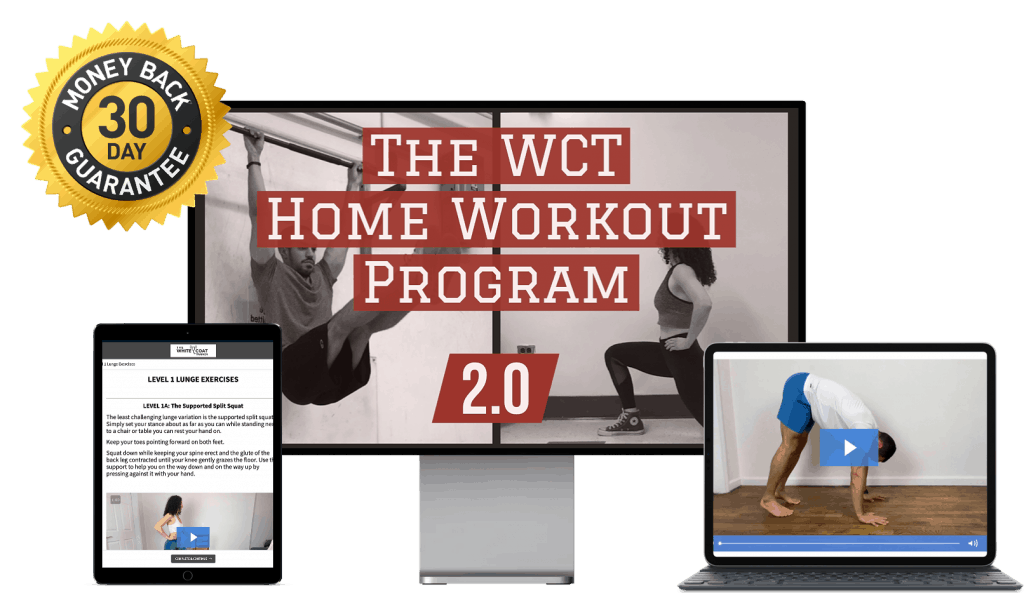
Okay, so now it’s time for you to get to work.
So which of these templates are you going to use first?
Comment below and let me know.
Related Posts On Split Workout Training
- The 3 Best Workout Splits Of All Time (With Templates)
- The Push Pull Legs Split For Busy Professionals
- The Best Full Body Workout Split For Busy Profesionals

Alex Robles, MD, CPT / Brittany Robles, MD, MPH, CPT
Alex & Brittany Robles are physicians, NASM Certified Personal Trainers, and founders of The White Coat Trainer: a resource dedicated to improving the health and fitness of busy professionals using time-efficient strategies. Their advice has been featured in My Fitness Pal, Prevention, Livestrong, Reader’s Digest, Bustle, The Active Times, and more. Learn more about them here.
